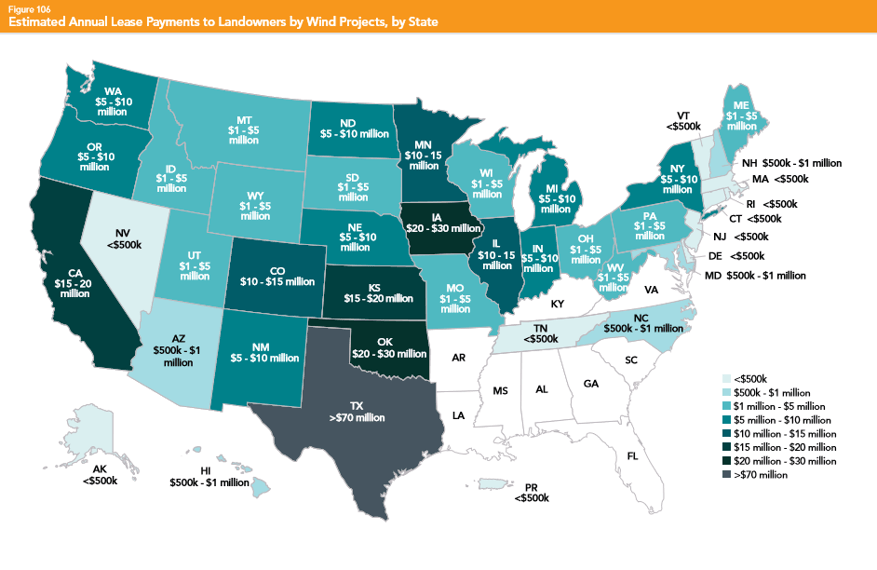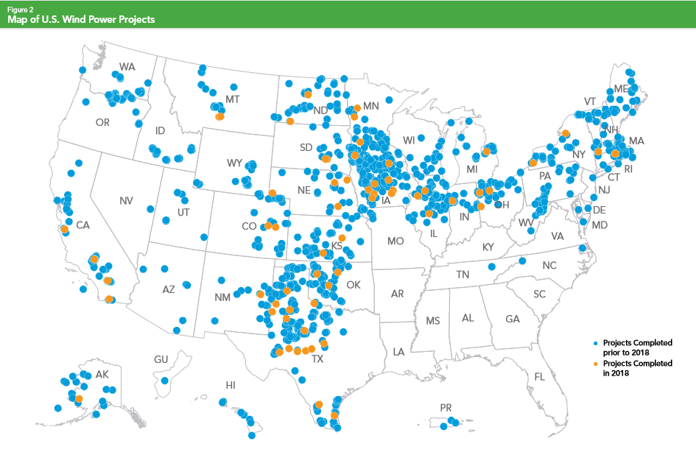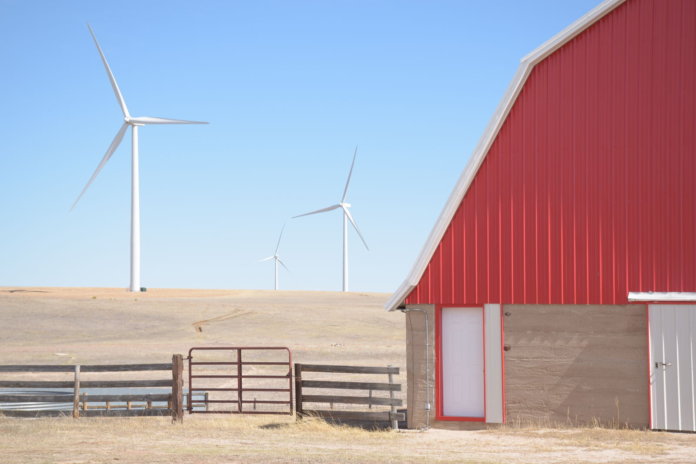U.S. wind power now supports 114,000 American jobs, over 500 domestic factories, and more than $1 billion per year in revenue for states and communities that host wind farms, according to the American Wind Energy Association (AWEA).
AWEA’s newly released “U.S. Wind Industry Annual Market Report, Year Ending 2018” shows that the industry saw an 8% growth in capacity last year.
Wind power is big business for Texas in particular, which ranked first for installed wind power capacity and wind jobs in 2018. Further, in Texas and across the nation, Fortune 500 brands and utilities alike purchased a record amount of new wind energy through long-term contracts.
“Wind power’s record-breaking year shows our industry is leading the way to a cleaner, stronger, 21st-century U.S. economy,” says Tom Kiernan, CEO of AWEA. “America’s least expensive source of new electricity generation is also clean and inexhaustible, which gives our economy an edge in the global marketplace. We’re proud to report the wind industry employs a record number of Americans, supports a robust domestic manufacturing sector with over 500 factories, and contributes over a billion dollars a year to states and rural communities.”
Texas
There are wind farms or factories supplying the industry in all 50 states, but no state exemplifies these trends better than Texas, says AWEA. The Lone Star State is home to roughly a quarter of all U.S. wind power capacity. If Texas were a country, it would rank fifth in the world for wind power capacity, with nearly 25 GW installed. It also had nearly 7 GW of additional wind projects under construction or in advanced development at the end of 2018.
Texas’ leadership in wind capacity means it also leads in wind industry jobs and investment, the report notes. Texas is the top state for direct and indirect wind industry jobs, with more than 25,000 Texans working in the industry. Wind farms in Texas have drawn over $46 billion in total capital investment to date and pay approximately $307 million each year in landowner payments, plus state and local taxes, according to AWEA’s findings.
Kiernan adds, “Texas has a long and storied history of energy production, and as today’s report demonstrates, wind is an important part of the state’s energy success story. In many ways, the Texas wind story is the story of American wind power.”
Rural America
The report says wind farms pay $1.05 billion per year through state and local taxes plus lease payments to landowners. To arrive at this number, AWEA quantified the $761 million per year paid by wind farms in state and local taxes, which help communities improve their school systems, fix roads and fund emergency services. An additional $289 million per year in land lease payments serves as a valuable drought-proof cash crop for American farmers and ranchers, the report says. Most of these revenues go to rural areas, where 99% of America’s wind-generating capacity can be found.
“Communities across Texas and the nation feel the benefits wind power delivers,” Kiernan continues. “Wind farm revenue enabled Blackwell Consolidated Independent School District, located near Abilene, Texas, to build a new school building, buy new technology, and provide scholarships worth $36,000 to students attending 1st through 12th grades. And that’s just one of the more than 100 districts in Texas that have seen the benefits of wind power in their community.”

Jobs
Citing the U.S. Bureau of Labor Statistics, AWEA says wind turbine service technician is the second fastest-growing job in the U.S. after solar installer. The U.S. added 8,500 wind power jobs last year, including well-paying jobs in wind turbine service, construction, engineering and manufacturing. Veterans are hired for many of these jobs – specifically, at a rate that is 67% higher than the national average, says AWEA. There are also 24,000 manufacturing jobs found at over 500 U.S. factories supplying the wind industry.
Corporate demand
Last year, non-utility buyers, including Fortune 500 brands, cities and universities, signed long-term contracts for a total of 4,203 MW, representing a 66% increase over the previous record set in 2015. To put that in perspective, cumulative non-utility wind purchases now exceed 11,300 MW, which is more than all the wind farms built to date in Iowa, America’s No. 2 state for wind power. Utilities also contracted over 4,300 MW of wind power last year, the report says.
Again, Texas is the nexus for non-utility demand for wind power, AWEA points out. At this time, 38 companies have purchased or committed to buy 4,900 MW of wind energy in Texas, including Fortune 500 brands such as AT&T, Budweiser, Walmart, ExxonMobil and Shell Energy. Wind even helps power other Texas energy industries: ExxonMobil purchased wind power to cost-effectively supply its Permian Basin operations.
New peaks
U.S. wind power capacity increased 8% in 2018 to 96,433 MW of cumulative installed wind capacity – more than double the capacity the U.S. had in 2010. The U.S. now has enough installed wind capacity to power over 30 million American homes. Further, wind projects installed in 2018 alone represent more than $12 billion in new private investment, the report says.
Wind energy now delivers over 20% of the electricity produced in six states: Kansas, Iowa, Oklahoma, North Dakota, South Dakota and Maine. In 2018, wind turbines generated 6.5% of all the electricity delivered to U.S. consumers.
Looking ahead, the wind industry has a record amount of generation set to come online in the near future, with 35,135 MW of wind power capacity either under construction or in advanced development across 31 states. Upon completion of these construction projects, the U.S. will have enough installed wind capacity to power 42 million American homes.
America’s offshore wind sector is also poised to rapidly scale up from a single, 30 MW project currently installed (the Block Island Wind Farm) to six offshore wind projects totaling 2,101 MW that project developers expect to be operational by 2023.





